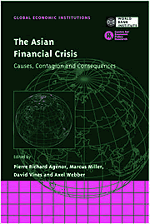Book contents
- Frontmatter
- Contents
- List of figures
- List of tables
- Preface
- List of conference participants
- Acknowledgements
- List of abbreviations and acronyms
- Introduction
- Part One General Accounts
- Part Two Theoretical Contributions
- Part Three Contagion
- Part Four Policy Responses
- 11 Coping with crises: is there a ‘silver bullet’?
- 12 Must financial crises be this frequent and this painful?
- 13 Round Table discussion
- Index
13 - Round Table discussion
from Part Four - Policy Responses
Published online by Cambridge University Press: 26 February 2010
- Frontmatter
- Contents
- List of figures
- List of tables
- Preface
- List of conference participants
- Acknowledgements
- List of abbreviations and acronyms
- Introduction
- Part One General Accounts
- Part Two Theoretical Contributions
- Part Three Contagion
- Part Four Policy Responses
- 11 Coping with crises: is there a ‘silver bullet’?
- 12 Must financial crises be this frequent and this painful?
- 13 Round Table discussion
- Index
Summary
The final section of the book is an updated report on a Round Table discussion which was held at the conclusion of the conference on ‘World Capital Markets and Financial Crises’, University ofWarwick (24–25 July 1998). The discussion produced a comprehensive review of thinking about the crisis, which is why we report it in full here. Richard Portes talked about early-warning indicators and LOLR facilities. Phillip Turner spoke about risk in financial markets and the role of the public sector in the context of such risk. Finally, Charles Goodhart talked about the impact of external events on the exchange rate and also on the treatment of foreign currency debt, both of which have implications for the IMF programmes.
Richard Portes
Robert Rubin says that ‘The purpose of IMF packages is to help Korea, a by-product is that we help investors and creditors.’ Do we really agree with this? Or do we think that IMF packages do this? Or do they mainly create moral hazard? Start with Mexico. Of course it is impossible to demonstrate from the data that the Mexican bail-out, through creating moral hazard, contributed to what we have observed in Asia. But I believe passionately that it did. I would be delighted if anybody here could suggest ways in which we could observe in the data the effects of the moral hazard that such rescues create. But what we have observed in the Asian sequence is the creation of further moral hazard.
Take the Korean bail-out. What happened? During three weeks in December 1997 the IMF package of 10 bn dollars went directly into reducing the short-term exposure of the banks.
- Type
- Chapter
- Information
- The Asian Financial CrisisCauses, Contagion and Consequences, pp. 404 - 411Publisher: Cambridge University PressPrint publication year: 1999



